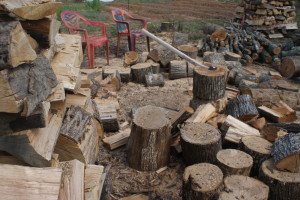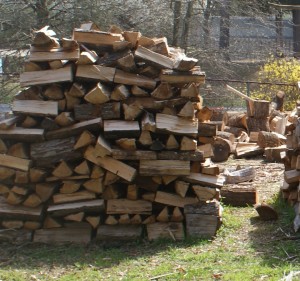 Here at Grateful Trees and Bees in Durham, North Carolina, every season is firewood season. As a tree services company with a recycling philosophy, we work hard to make sure nary a scrap of any tree we remove ends up in a landfill. When we do a tree removal or tree pruning we either help the client work up the wood for their own use, or bring it back to headquarters to reuse it as mulch or firewood. This means we do our fair share of piecing large logs into firewood, splitting those logs into firewood size pieces, stacking the split firewood and yes, when the cold winds blow, heating our home with the seasoned firewood.
Here at Grateful Trees and Bees in Durham, North Carolina, every season is firewood season. As a tree services company with a recycling philosophy, we work hard to make sure nary a scrap of any tree we remove ends up in a landfill. When we do a tree removal or tree pruning we either help the client work up the wood for their own use, or bring it back to headquarters to reuse it as mulch or firewood. This means we do our fair share of piecing large logs into firewood, splitting those logs into firewood size pieces, stacking the split firewood and yes, when the cold winds blow, heating our home with the seasoned firewood.
Since we’ve got the muscles and splinters to prove it, we thought we’d share with you a few tips we’ve gathered over the years on how to get the most out of heating with wood.
1. Water and fire don’t mix: use only seasoned firewood. The most important factor to consider in obtaining the maximum heating energy from wood is its moisture content. Simply put, burning wet wood wastes a lot of energy — it can be very hard to get lit and keep burning and often produces a lot of smoke. Optimal firewood should have a moisture content of 15-20%. You can purchase a moisture meter for an exact reading, but in general, look for wood that is an even faded color from rosy tan to an almost grayish hue. Avoid green wood which often looks white or off-white.
2. Always ask how long the firewood has been seasoned. A good rule of thumb is to burn in the fall and winter firewood that has been split, stacked and dried the previous spring. However, in North Carolina, with our long growing season and attendant warm, sunny days, properly split and stacked firewood can cure in a matter of months, so it’s okay if the wood was split as late as early summer. This is particularly true if the firewood is worked up from a dead tree.
 3. The best firewood is what is sustainably available. The energy potential of wood is measured when the wood is dry and expressed in British thermal units (BTU), the amount of energy needed to cool or heat one pound of water by one degree Fahrenheit. All wood burns with the same heat, but a denser wood such as oak, hickory, sycamore or ironwood will burn longer. However, it is still okay to burn softer woods, such as ash, poplar, sweetgum, maple and cedar, particularly if they are the species readily available. While pine is abundant in North Carolina and will burn well, we do not recommend using it for indoor heating. The high sap content of pine generates excess creosote when burned that will quickly clog your chimney or flue. Save your pine firewood for outdoor fire pits or external wood stoves.
3. The best firewood is what is sustainably available. The energy potential of wood is measured when the wood is dry and expressed in British thermal units (BTU), the amount of energy needed to cool or heat one pound of water by one degree Fahrenheit. All wood burns with the same heat, but a denser wood such as oak, hickory, sycamore or ironwood will burn longer. However, it is still okay to burn softer woods, such as ash, poplar, sweetgum, maple and cedar, particularly if they are the species readily available. While pine is abundant in North Carolina and will burn well, we do not recommend using it for indoor heating. The high sap content of pine generates excess creosote when burned that will quickly clog your chimney or flue. Save your pine firewood for outdoor fire pits or external wood stoves.
4. Store your wood with care and pride. Wood should be stacked so that air can easily circulate through the pile. If possible elevate the stack off of the ground by using cement blocks or downed tree limbs to form the base. This will keep the bottom pieces of wood from decaying in rain soaked earth. While it isn’t necessary to cover a wood pile, when possible, stack your firewood under a tree, shed or porch to keep it dry. We’re also pretty sure that wood pile pride will overcome you as you step back to view your work. There is something comforting and beautiful about stacking wood for winter.
5. Give yourself a green pat on the back. When firewood is harvested sustainably, is properly seasoned prior to burning and is burned in an efficient wood stove, it is an environmentally responsible way to heat your home.
© 2014 Grateful Trees & Bees

